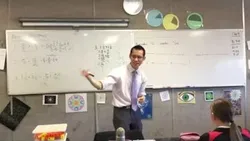
Basic Linear Relationships 
This course covers the basics of linear relationships, including plotting and locating points on the number plane, as well as transformations such as translation. Students will learn how to read coordinates and use them to plot points, as well as how to apply transformations to the number plane. ▼
ADVERTISEMENT
Course Feature
![]() Cost:
Cost:
Free
![]() Provider:
Provider:
Youtube
![]() Certificate:
Certificate:
Paid Certification
![]() Language:
Language:
English
![]() Start Date:
Start Date:
On-Demand
Course Overview
❗The content presented here is sourced directly from Youtube platform. For comprehensive course details, including enrollment information, simply click on the 'Go to class' link on our website.
Updated in [February 21st, 2023]
Coordinates on the Number Plane.
Plotting on the Number Plane (1 of 2: Reading Coordinates).
Plotting on the Number Plane 2of 2: Locating Points).
Transformations on the Number Plane (1 of 2: Translation).
Transformations on the Number Plane (2 of 2: Rotation & Reflection).
Coordinate Geometry - Rectangle Puzzle.
Features of the Cartesian Plane.
Comparing Linear & Non-Linear Functions.
Intersections of Linear Graphs.
(Please note that we obtained the following content based on information that users may want to know, such as skills, applicable scenarios, future development, etc., combined with AI tools, and have been manually reviewed)
1. You can learn the basics of linear relationships, such as coordinates on the number plane, plotting points, transformations, coordinate geometry, features of the Cartesian plane, comparing linear and non-linear functions, and intersections of linear graphs.
2. You can gain a better understanding of the number plane and how to read coordinates, locate points, and use transformations such as translation, rotation, and reflection.
3. You can learn how to use coordinate geometry to solve puzzles and compare linear and non-linear functions.
4. You can gain an understanding of the features of the Cartesian plane and how to identify and calculate the intersections of linear graphs.
5. You can develop your problem-solving skills by applying the concepts you have learned to solve real-world problems.
[Applications]
After completing this course, students should be able to apply the concepts learned to solve problems involving linear relationships. They should be able to plot points on the number plane, identify and describe transformations, and compare linear and non-linear functions. Additionally, they should be able to identify the features of the Cartesian plane and find the intersections of linear graphs.
[Career Paths]
1. Data Analyst: Data Analysts use data to identify trends and patterns in order to make informed decisions. They use a variety of tools and techniques to analyze data, such as linear regression, machine learning, and predictive analytics. As the amount of data available continues to grow, the demand for Data Analysts is expected to increase.
2. Statistician: Statisticians use mathematical and statistical methods to analyze data and draw conclusions. They use linear regression and other techniques to identify trends and patterns in data. With the increasing availability of data, the demand for Statisticians is expected to grow.
3. Data Scientist: Data Scientists use a variety of tools and techniques to analyze data and draw conclusions. They use linear regression and other techniques to identify trends and patterns in data. As the amount of data available continues to grow, the demand for Data Scientists is expected to increase.
4. Business Analyst: Business Analysts use data to identify trends and patterns in order to make informed decisions. They use a variety of tools and techniques to analyze data, such as linear regression, machine learning, and predictive analytics. With the increasing availability of data, the demand for Business Analysts is expected to grow.
Course Provider

Provider Youtube's Stats at AZClass
Discussion and Reviews
0.0 (Based on 0 reviews)
Explore Similar Online Courses

Turn Your Art Into An NFT - Join The World Of Digital Art

Spring Security FULL COURSE

Python for Informatics: Exploring Information

Social Network Analysis

Introduction to Systematic Review and Meta-Analysis

The Analytics Edge

DCO042 - Python For Informatics

Causal Diagrams: Draw Your Assumptions Before Your Conclusions

Whole genome sequencing of bacterial genomes - tools and applications

Linear Algebra: Help & Tutorials

Eigenvectors and Eigenvalues


Start your review of Basic Linear Relationships